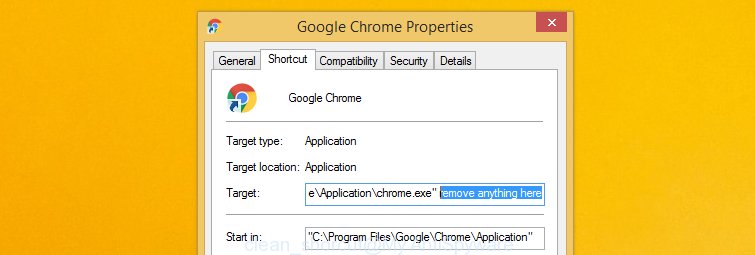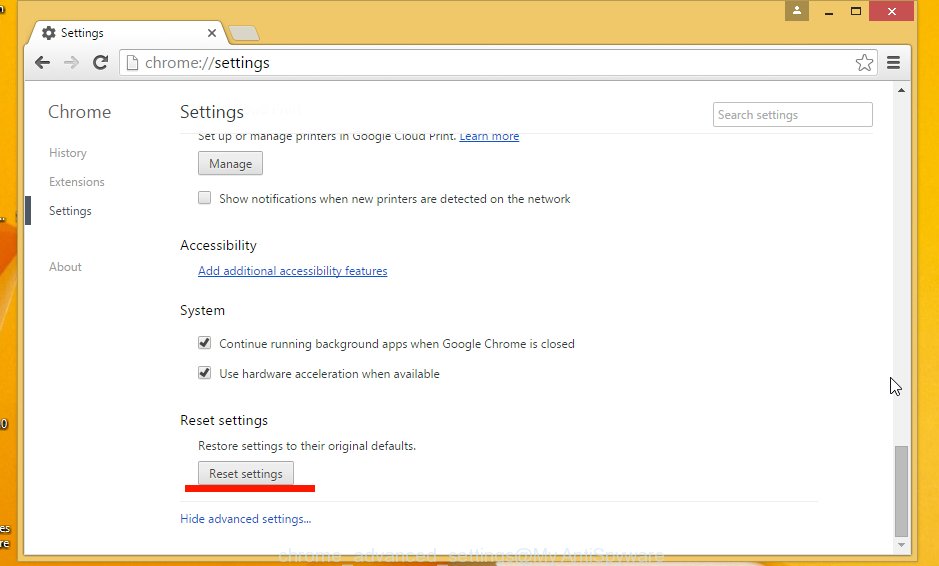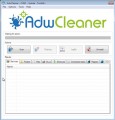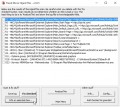If your antivirus detects TrojanDropper:JS/Exjaysee.A then it indicates that your computer is infected with a previously unknown malicious software. This unwanted software usually come with some freeware or from malicious websites that ask users to download and run a Flash Player or Java update. Once started, the TrojanDropper:JS/Exjaysee.A will be configured to start automatically when Windows starts. The unwanted software may display large number unwanted popups, inject ads into web-pages that you are opening in the Internet browser, hijack the web-browser’s settings such as homepage and search engine, and so on.
If you find that your anti-virus software detects the TrojanDropper:JS/Exjaysee.A threat, then don’t wait, follow the step-by-step guide below which will help to remove TrojanDropper:JS/Exjaysee.A and any associated malware for free.
Common symptoms of TrojanDropper:JS/Exjaysee.A
If you still are not sure that your computer is infected with this parasite, then check your computer for the common symptoms of the infection:
- Your browser displays banner ads where previously you have never seen.
- Google Chrome, Mozilla Firefox and Microsoft Internet Explorer (Edge) shows a lot of annoying advertisements.
- Web browser’s settings such as homepage and default search engine are hijacked
- Your an antivirus or antispyware software detects an infection.
- Internet connection may be slow.
How to remove TrojanDropper:JS/Exjaysee.A
The following instructions is a step-by-step guide, which will help you manually remove TrojanDropper:JS/Exjaysee.A and clean your computer.
- Scan your computer with MalwareBytes Anti-malware
- Scan your computer with AdwCleaner
- Scan your computer with Kaspersky Virus Removal Tool
- Disinfect browser’s shortcuts
- Reset web-browser’s settings
- Protect your computer from annoying ads and malicious sites
Scan your computer with MalwareBytes Anti-malware
We recommend you to scan your PC with the MalwareBytes Anti-malware Free. It is a free software that will help you to remove unwanted programs, adware and toolbars that your computer may be infected.
- Download MalwareBytes Anti-malware (MBAM) from the link below.
Malwarebytes Anti-malware
327280 downloads
Author: Malwarebytes
Category: Security tools
Update: April 15, 2020
- Close all programs and windows on your computer. Open a directory in which you saved it. Double-click on the icon that named mbam-setup.
- Click Next and follow the prompts.
- Once installation is complete, click on the “Scan Now” button to start scanning your computer. This procedure can take some time, so please be patient.
- When the scan is finished, make sure all entries have “checkmark” and click “Remove Selected”. Once disinfection is completed, you may be prompted to Restart.
Scan your computer with AdwCleaner
if MalwareBytes Anti-malware cannot remove the TrojanDropper:JS/Exjaysee.A, then we suggests to use the AdwCleaner. AdwCleaner is a free removal tool for browser hijackers, adware, PUPs, toolbars. Also you can ask for help our Myantispyware team below.
- Download AdwCleaner from the link below.
AdwCleaner download
225634 downloads
Version: 8.4.1
Author: Xplode, MalwareBytes
Category: Security tools
Update: October 5, 2024
- Double click the AdwCleaner icon. Once this tool is started, press “Scan” button to perform a system scan for [HIJACKER].
- Once AdwCleaner has finished, it will open a scan report. Review the report and then click “Cleaning” button. It will display a prompt. Click “OK”.
Scan your computer with Kaspersky virus removal tool
Kaspersky virus removal tool is a well-known free security tool. It uses the Kaspersky Anti-Virus engine to detect and remove viruses, trojans and malware.
- Download Kaspersky virus removal tool from the following link and save it directly to your Windows Desktop.
Kaspersky virus removal tool
129296 downloads
Author: Kaspersky® lab
Category: Security tools
Update: March 5, 2018
- Double-click on the KVRT icon found on your desktop. Once initialization process is finished, you will see the Kaspersky virus removal tool screen.
- Click Change Parameters and set a check near all your drives. Click OK to close the Parameters window.
- Press Start scan button. Kaspersky virus removal tool will now start scanning your computer for known infections. This procedure can take some time, so please be patient.
- When KVRT has finished scanning, click on Continue to start a cleaning process.
Disinfect browser’s shortcuts
The TrojanDropper:JS/Exjaysee.A may also change a desktop shortcut for Chrome, Firefox and IE. Due to this, every time you start the browser, it will open an unwanted web-site.
To clear a browser shortcut, right-click to it and select Properties. On the Shortcut tab, locate the Target field. Click inside, you will see a vertical line – arrow pointer, move it (using -> arrow key on your keyboard) to the right as possible. You will see a text that has been added here. You need to remove it.

When the text is removed, press the OK button. You need to clean all desktop shortcuts for all web-browsers, as they may be infected too.
Reset web-browser’s settings
Chrome
Open the Google Chrome menu by clicking on the button in the form of three horizontal stripes (

Scroll down to the bottom of the page and click on the “Show advanced settings” link. Now scroll down until the Reset settings section is visible, as shown below and click on the Reset settings button.

Confirm your action, click on the Reset button.
Firefox
Open Mozilla Firefox menu by clicking on the button in the form of three horizontal stripes (

In the Help menu click on the “Troubleshooting Information”. In the upper-right corner of the “Troubleshooting Information” page click on Refresh Firefox button.

Confirm your action. Click on the Refresh Firefox.
Internet Explorer
Open the Internet Explorer tools menu by clicking on the button in the form of gear (

In the Internet Options window click on the Advanced tab, then click the Reset button. The Internet Explorer will show the Reset Internet Explorer settings window. Select the Delete personal settings check box, then click on Reset button.

You will now need to restart your computer for the changes to take effect.
Protect your computer from annoying ads and malicious sites
To increase your security and protect your computer against new annoying ads and malicious web sites, you need to use an application that blocks access to dangerous ads and web-pages. Moreover, the software can block the display of intrusive advertising, which also leads to faster loading of websites and reduce the consumption of web traffic.
- Download AdGuard program using the following link.
Adguard download
26903 downloads
Version: 6.4
Author: © Adguard
Category: Security tools
Update: November 15, 2018
- After the download is complete, run the downloaded file. You will see the Setup Wizard program window. Follow the prompts.
- After installation is complete, click “Skip” to close the installation program and use the default settings, or press “Get Started” to see an quick tutorial that will help you get to know AdGuard better.
- In most cases, the default settings are enough and you do not need to change anything. Each time, when you start your computer, AdGuard will start automatically and block pop-up ads, sites such TrojanDropper:JS/Exjaysee.A, as well as other malicious or misleading web page. For an overview of all the features of the program, or to change its settings you can simply double-click on the icon AdGuard, which is located on your desktop.
How to ask for help the Myantispyware team
If you are seeking a help for TrojanDropper:JS/Exjaysee.A removal then follow these steps.
- Download HijackThis from the link below and save it to your Desktop.
HijackThis download
5001 downloads
Version: 2.0.5
Author: OpenSource
Category: Security tools
Update: November 7, 2015
- Double-click on the HijackThis icon, and click the button labeled “Do a system scan only”.
- Once the scan is complete, the scan button will read “Save log”, click it. Save this log to your desktop
- Copy and paste the contents of the HijackThis log into your post. If you are posting for the first time, please start a new thread by using the New Topic button in the Spyware Removal forum. When posting your HJT log, try to give us some details about your problems, so we can try to help you more accurately.
- Wait for one of our trained “Security Team” or Site Administrator to provide you with knowledgeable assistance tailored to your problem with TrojanDropper:JS/Exjaysee.A removal.
Create a Myantispyware account here. Once you’ve registered, check your e-mail for a confirmation link, and confirm your account. After that, login.





















